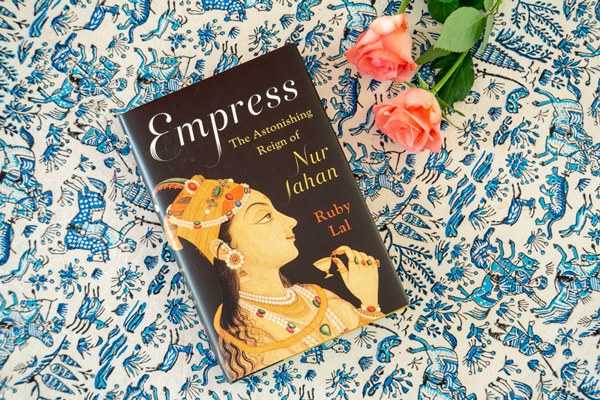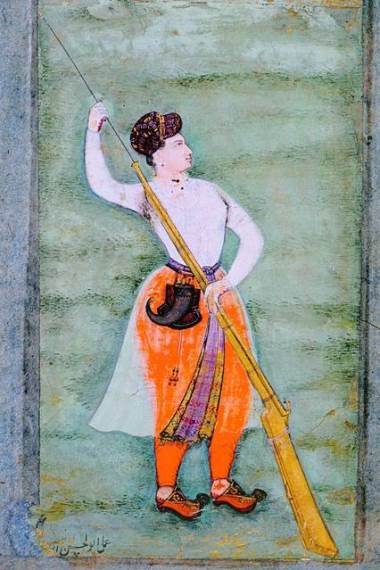One doesn’t often see empresses portrayed loading a gun, but among the many representations of Nur Jahan, the 17th century Mughal sovereign, the most famous shows her doing just that. She’s standing against a leafy landscape, dressed in a man’s turban, orange trousers and a transparent silk coat. The musket is long and unwieldy, but she handles it with ease. Her posture is confident, bold and self-assured. When the painting was presented to Nur Jahan’s husband, the emperor Jahangir, he proclaimed it perfect and named the court painter Abul-Hasan, Nadir uz-Zaman, the Wonder of the Age. But as the historian Ruby Lal notes in her book, Empress : The Astonishing Reign of Nur Jahan, the true wonder was the subject of the painting herself.

Nur Jahan (1577-1645) was born Mihr un-Nissa, a daughter of Persian nobles who left the repressive conditions of Safavid Iran for the greater freedom–and wealth–of Mughal India. She became Nur Jahan, the Light of the World, when she married Jahangir in 1611. She was an unconventional imperial spouse, because she was not only past the nubile age–she was 34 at the time of their betrothal, but also a widow and a mother. Records don’t tell us exactly how the meeting between Mihr and Jahangir happened. What we know for sure is how much the emperor esteemed his wife, describing her bravery, archery and shooting skills, her wisdom, and her generosity at length in his journal, Jahangirnama.
As Jahangir’s health declined, in no small part due to his opium and alcohol addiction, he entrusted power to Nur Jahan. She issued imperial orders in her name, appeared at royal functions alongside the emperor and minted coins that bore her name, an unprecedented move in the Mughal empire. She was both feared and respected, lauded and judged. Even as many nobles were uncomfortable with a powerful female figure at the helm of the state, Nur Jahan’s achievements couldn’t be denied.
Lal’s book brings Nur Jahan’s character to light. Many other historians gloss over her, either focusing on the great Mughal monarchs like Akbar (1542-1605) or his grandson Shah Jahan (1592–1666) or dismissing the idea that a woman in Mughal India could wield real power. It’s a shame, because hearing a diversity of voices makes our understanding of the past greater. While Nur Jahan lived in a conservative, patriarchal society, she nevertheless showed that the boundaries were less rigid and the limitations less severe than might seem at first glance.

Nur Jahan Holding a Musket by Abul-Hasan, 17th century
Nur Jahan’s is an inspiring and engrossing story, and I read it in one evening, stopping only to search for images of the mosques, public baths, gardens, and mausoleums designed by the empress that still grace Agra, Lahore and Delhi. (Lal’s book includes several color plates, but I wanted more.) Not only Nur Jahan, but also other Mughal characters, parade before our eyes, from Jahangir himself, a man fascinated with the natural world and philosophy, to Gulbadan Begum, the first Mughal historian. Lal’s book recreates vividly the world of the Mughals–the pleasure gardens, court painting sessions, travels to Kashmir, celebrations as well as intrigues and insurrections.
Perfume lovers will appreciate the story of how rose essence was discovered–courtesy of Nur Jahan’s mother. The anecdote was touchingly recorded by Jahangir in his journal, and Lal explains its significance.
As I was reading, I was thinking how easily remarkable individuals, especially women, can slip out of our gaze, since historians have their own prejudices and blind spots. It doesn’t mean, however, that they are not there. As Lal aptly reminds us, some individuals write themselves into history, and Nur Jahan left many tangible clues to her larger-than-life personality.
Ruby Lal. Empress : the astonishing reign of Nur Jahan. New York, NY : W.W. Norton & Company, 2018 (public library).
Top image by Bois de Jasmin
















41 Comments
Sandra: Dear Victoria-
I am reading this one right now! Very good so far! Thank you for this review and I hope other readers of this blog will become interested so we can all discuss.
At the same time (am I the only ones who reads 2 books at a time?) I am reading Call me Zebra by a young talented author Azareen Van der Vliet Oloomi.
I just finished Sand by Wolfgang Herrndorf, if anyone likes a murder mystery. This book was recently translated into English. I couldn’t put it down. August 6, 2018 at 7:31am
AndreaR: I am enjoying this book too. It’s always fun to hear about the books BdJ readers enjoy. August 6, 2018 at 9:21am
Sandra: This is my first reading a book of this type. Have you read others along the same lines? August 6, 2018 at 9:38am
Victoria: Another one I’ve started reading is called Rebel Sultans. It’s about the South India sultans, who were real characters. August 6, 2018 at 2:30pm
Victoria: I’m so glad to hear it! August 6, 2018 at 2:30pm
AndreaR: I was intrigued the moment I read that Nur Jahan wore earrings and a necklace of diamonds, rubies and pearls to hunt and expertly kill the tiger who was terrorizing the village. August 6, 2018 at 2:52pm
Victoria: That was a great story! August 7, 2018 at 5:49am
AndreaR: And a reminder to dress for success:-) August 7, 2018 at 10:43am
Victoria: LOL! I’ll remember this when I have any tigers to slay (metaphorical ones, in my case). August 7, 2018 at 10:47am
Victoria: I also read more than one book at a time, and right now I’m also reading Ella Maillart’s The Bitter Way, about her journey through Central Asia and Afghanistan on the eve of WWII.
I’m intrigued by Sand. August 6, 2018 at 2:32pm
Sandra: Is there another title for you book by Maillart? I couldn’t find it. Maybe its not released in the USA.
Sand is good, Herrndorf writes with a bit of humor. It is a book that demands your attention though or else you will not be able to connect the dots.
While reading Empress Nur Jahan did you wear a rose perfume? August 7, 2018 at 8:52am
Victoria: Let me check. I think it’s The Cruel Way (La Voie Cruelle in French).
I read Ruby Lal’s book in one evening, and it’s been too hot for perfume these days. August 7, 2018 at 10:45am
Victoria: Yes, it’s The Cruel Way.
https://www.press.uchicago.edu/ucp/books/book/chicago/C/bo15331634.html
Do take a look at her other books too. She was an explorer and traveled all over Asia and the Middle East. August 7, 2018 at 10:46am
Sandra: Perfect thank you!
I will add this one and the rebel sultans to my autumn reading list.
Its been really hot here in NYC. We have a heat advisory and I have been keeping my two little kiddos cool. Today I am in Songes.
I can’t remember the last time I read a book in one evening… kudos to you. August 7, 2018 at 11:10am
Victoria: It’s been sweltering here too. I’ve made another batch of my fennel-cardamom sharbat. Otherwise, I make a big jug of water mixed with Persian herb distillates (mint, rose or willow) and ice. Refreshing and cooling. August 7, 2018 at 11:33am
matty: Sounds a very interesting read. August 6, 2018 at 11:02am
Victoria: I very much enjoyed it. August 6, 2018 at 2:29pm
Emilie: She sounds like a fascinating woman! Was she the one who became a perfumer while under house arrest? I wonder if there are any descriptions or ingredient lists of her creations floating around… August 6, 2018 at 3:49pm
Victoria: The author doesn’t mention it in her book, and there doesn’t seem to be many records on her life once Shah Jahan became emperor and pushed her out of the way. But since making perfume was an important part of Mughal culture, it’s quite possible. August 7, 2018 at 5:50am
Emilie: I think I’m mixing her up with someone else but now I certainly want to learn more about Nur Jehan. Perhaps this one will go on my Christmas book list (it’s getting ridiculously long!) August 7, 2018 at 6:19am
Victoria: I can imagine! My list is always long, but to be honest, I just read whatever catches my interest, without following a specific order anymore. Too many great books around! August 7, 2018 at 10:42am
Emilie: Very wise! I’m a sucker for meaning to read what looks like a great new release… but in the meantime getting sidetracked and re-reading an old favourite three times over! August 7, 2018 at 12:49pm
Victoria: Why not! It’s such a pleasure to re-read old favorites. I used to think that I must read as many new books as possible, but honestly, sometimes I derive more from re-reading the ones that moved me in the first place, and I derive even more out of them. August 9, 2018 at 2:24am
Emilie: This is true 🙂 You will always discover new facets or insights each time you read a really wonderful book.
Also it can be so comforting! I’m finding this winter for some reason I am re-reading all my old childhood favourites. Tove Jansson’s Moomin books give me the same cosy feeling as sitting in front of a fire with a hot chocolate. Pure delight! August 9, 2018 at 6:53am
Annie: Me too! I reread them with my kids every winter. I think I enjoy rereading them the most. 🙂 August 13, 2018 at 8:07am
Emilie: Aww it was my Mum who first read them to me when I was little! They are going to have such fond memories of those books now 🙂 August 13, 2018 at 7:35pm
Victoria: You make me want to pick it up and re-read it! 🙂 August 14, 2018 at 10:55am
Gaye Rowley: This sounds fascinating! Many thanks indeed for letting us know about Ruby Lal’s new book: it’s gone straight on to my to-read list. August 6, 2018 at 5:47pm
Victoria: Hope that you enjoy it. It really takes you into that long vanished world. August 7, 2018 at 5:51am
Christine M: Such a lovely article to read on my way home from work on the train last night Victoria- we should be paying you for this August 7, 2018 at 6:32pm
Victoria: Thank you for your kind words, Christine! August 9, 2018 at 2:24am
Christine M: It’s a pleasure- love your blog! August 9, 2018 at 3:38pm
Sherry Frantz: Persian women are always so independent. Contrary to what people think. This lady was an example. That are still like that even a the mullahs have tried to oppress them 🙂 August 14, 2018 at 2:06am
Victoria: They are. In general, women are very much part of the public life in Iran. August 14, 2018 at 11:14am
Silvermoon: Absolutely intend to read this one. I was always fascinated by Nur Japan when studying history in school in India.
Also, I love reading biographies of women (never have been interested in reading biographies of men). Two excellent books are Alison Weir’s biography of Eleanor of Aquitaine and Helen Castor’s multiple short biographies under the title of She Wolves. Both dealing with women in pre Elizabethan England. August 14, 2018 at 6:41am
Victoria: Thank you for the extra recommendations! I’m especially drawn to the book by Weir. August 14, 2018 at 11:14am
Silvermoon: Victoria, I would recommend it very highly. Eleanor was a formidable woman- wife of two kings and mother of kings. A strong, intelligent and highly cultured woman. And the book is an excellent one. Hope you enjoy it.
I am looking forward to reading the one about Nur Jahan August 14, 2018 at 12:23pm
Victoria: Thank you, I will do! August 16, 2018 at 2:25am
Banditqueen: I was delighted to see this book in a local bookshop as I was aware of Nur Jahan from documentary films on India and the Moghol Empire and its Art. I didn’t realise just how powerful and magnificent she was. I have seen the designs on her tomb and parents tombs and you can see how influential her ideas are. It is a romantic story of how she met and enchanted Jahangir but it is also a soulful story. There was something impressive about this widow from his Harem which meant he had to marry her and bring her to rule at his side in public. It is also tragic because his alcoholism led him to be dependent on her and she had to take control. It is also a story of family drama and intrigue as rebellious sons battle for power and Nur campaigns for her favourite against the heir chosen by her husband. Her retirement meant she could dedicate herself to the life work of building the beautiful tombs for which she is remembered. Professor Lahl has brought this remarkable woman out of the veil of history and her book is beautifully written. I would recommend it 1000 times over. Thank you for your article. September 13, 2018 at 9:41pm
Victoria: Very happy to read this! September 18, 2018 at 3:06am
Ia: Victoria, your review of the Ruby Lal’s book brought to my mind another book on the subject of the Mughal Empire – The Enchantress of Florence by Salman Rushdy. The narrative is divided between the courts of Emperor Akbar (Nur Jahan’s father in law) and the Medici.
There is a delectable passage in The Enchantress of Florence about a perfume. An Italian traveller must have an audience with Akbar. The traveller is anointed with a “fragrance devised for the seduction of kings” that will open the right doors and will gain him this audience. The unique quality of this perfume is that the increasingly complex layers reveal themselves one by one at the right time to enchant those who have the power to give or deny entry first into the city, then into the palace, and finally to the Emperor. October 15, 2019 at 10:26pm